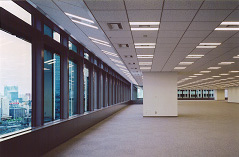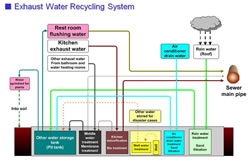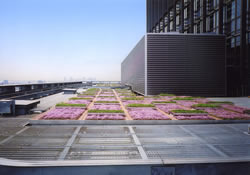Shinmarunouchi Building
Development of air diffusers for thermal load reduction (formation of heat reservoir in window perimeter)
 |
|||
| Office perimeter zone | |||
 |
 |
 |
 |
Ceiling in standard-floor office space inclines upward near windows, enhancing openness and superb views of workplace. Based on the thermal load process of the windows, with improved thermal performance using Low-E glass, specific air diffusers were developed to form an optimal thermal reservoir to reduce the cooling load in slanted ceiling areas, achieving the most effective air flow performance as determined by environmental testing under simulated ceiling and exterior conditions.
Air barrier system
 |
|||
| Air barrier system and blind control | |||
 |
 |
||
A unique air barrier system was developed that diffuses air from window perimeter system via double floor space under raised access floor. To ensure even air diffusion, optimal shape for baseboard opening was analyzed through testing conducted with actual-size double floor simulation model in early stage of construction. The system, combined with thermal reservoir formation effect in slanted ceiling area, allows thermal load reduction, while also achieving effective discharge of high-temperature air by automatically switching between circulation and emission modes based on intake air temperature via blind box.
Waste heat utilization facility (cascade system)
 |
|||
| Waste heat utilization flow | |||
 |
 |
 |
|
In addition to being recycled for general service water, A/C condensation water from upper office floors is used in waste heat recovery/utilization system for outdoor air pre-cooler and floor cooling system in atrium lobby during the summer, after temporary storage in a collection tank on the 6th floor.
Basic air flow system using roll screens installed on the south side of the three-story atrium lobby reduces solar radiation load, while allowing waste heat from upper louvers to be used for preheating for hot-water system and outdoor intake air in the winter.
Waste water recycling system
 |
|||
| Waste water recycling flow | |||
 |
|||
Reduction of water consumption through extensive, building-wide use of greywater including kitchen water (excluding sanitary sewage from washroom facilities), rainwater and A/C condensation water.
Annual usage rate of recycled water in 2008: approximately 95%
High-rise greening test site and attention to continuity of green space
 |
|||
| Thin-layer greenery technology (34th floor, 160m above ground) | |||
 |
 |
 |
 |
 |
 |
||
At 160 meters above the ground, the 34th floor rooftop is utilized as a rooftop greening test site for analyzing environmental adaptability and safety of thin-layer green spaces in super high-rise buildings with exposure to strong winds and rain and is equipped with ground cover plants in shallow beds stacked over a water retention/drainage resin mat.
A number of trees are planted in the terrace area on the 7th floor and on the balcony on the 6th floor, creating visual continuity with the greenery of the nearby Imperial Palace and thus giving the impression of an expansive green space while reducing the urban heat island effect.
Previous Building |
 |
 |
 |
 |
 |
 Next Building Next Building |
CASBEE is a method for rating the environmental performance of buildings using Building Environmental Efficiency (BEE) as an indicator, which is based on the results of separate scores obtained for Q-1~Q-3 (Quality) and LR-1~LR-3 (Load Reduction).















 | Copyright © 2008 Institute for Building Environment and Energy Conservation, All Rights Reserved.
| Copyright © 2008 Institute for Building Environment and Energy Conservation, All Rights Reserved.